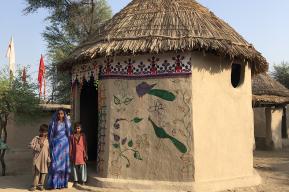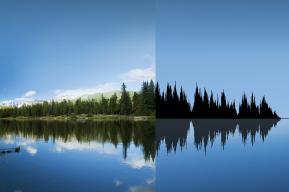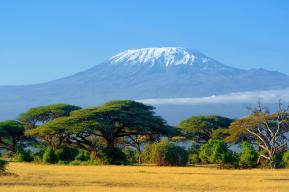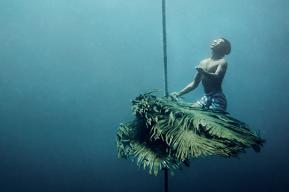文章
岛屿:展示生物多样性的脆弱窗口

岛屿仅占地球陆地面积的一小部分,却有着远胜于其他地区的生物多样性。由于外来入侵物种步步紧逼,许多岛屿物种如今面临灭顶威胁。人们正在采取措施,保护岛上得天独厚的自然资源。
丹娜·斯帕兹(Dena R. Spatz)
夏威夷环太平洋自然保护区高级环保科学家。
尼克·霍姆斯(Nick D. Holmes)
加州自然保护协会岛屿保护首席科学家。
各个岛屿的形成年代、地理位置和偏僻程度各不相同。由于这些特性,每座岛屿都是独一无二的,其生态系统因此能够衍生出当地特有的大规模动植物群落。其中一些物种在进化过程中逐渐形成了极为罕见的特点,例如体型特别巨大或矮小,或是有翅膀却不会飞行。
岛屿只占全球陆地面积的5%,却是全世界大约17%的鸟类和植物物种的栖息地。一些热带岛屿沿岸的珊瑚礁是全球生物多样性最丰富的生态系统,维持着数百万人的生计。许多岛屿物种只生活在某一个岛或群岛上,由此被认定为当地特有物种。
马达加斯加是地球上面积最大的岛屿之一,也是公认的全球生物多样性天堂。这里生活着15000种原生陆生植物,其中85%是当地特有的,包括千余种兰花。在夏威夷群岛,一种体型较小的陆生鸟类最先适应了岛上的生活,而后逐渐发展壮大,夏威夷如今有将近半数的陆生鸟类都是由之繁衍而来。这种鸟的后代之一夏威夷蜜旋木雀有50多个种类,每一种的喙和舌头形状都各有区别,分别适应不同的食物来源——种子、水果、昆虫或花蜜。这些鸟类生动地展示了岛屿物种进化之神奇。
渡渡鸟、象龟和伏翼
15世纪初以来,由于偷猎、栖息地丧失和外来物种猎食,全球61%的物种灭绝事件发生在岛屿上。我们都知道著名的渡渡鸟的种族命运,这种曾经生活在毛里求斯的不会飞的鸽子已经永远地消失了。但除了渡渡鸟之外,西南印度洋上的马斯克林群岛还失去了20多种岛屿原生物种,其中包括体型庞大且长寿的象龟。
岛上濒危物种的密集程度十分惊人
时至今日,物种灭绝事件仍在不断发生。在基里巴斯,圣诞岛伏翼——一种体重不到5克的小蝙蝠在2012年宣告灭绝。人们为拯救这种蝙蝠采取了保护措施,但为时已晚,它的踪迹最后一次被发现是在2009年。
在国际自然保护联盟(IUCN)《濒危物种红色名录》中,将近3000种鸟类、哺乳动物、爬行动物和两栖动物被列为濒危或极度濒危。研究发现,这其中41% 的物种在岛上繁衍后代。岛屿面积如此之小,濒危物种密集程度何其惊人,由此可见一斑。
外来入侵物种是造成物种灭绝的一个主要原因。外来物种离开其自然分布区域,进入其他地区(无论是有意为之还是无意之举),就会对当地原生物种和整个生态系统产生不利影响。有30种外来入侵物种已经被认为是导致全球738种动物灭绝的祸因。这些灭绝事件主要集中在岛屿上,86%的已知物种灭绝与岛上的外来物种脱不了干系。
外来入侵物种是造成物种灭绝的一个主要原因
入侵的哺乳动物造成的破坏尤其严重,猫和猫鼬等食肉动物捕食当地物种,山羊和猪等食草动物改变地貌,加剧栖息地的丧失。岛屿物种在进化过程中,通常不会遇到捕食、竞争和食草物种,正因如此,岛上才会演化出不会飞的鸟类和不长刺的植物,而且岛屿原生物种普遍生性天真幼稚,在面对具有侵略性的外来物种时特别脆弱。
在大西洋上的戈夫岛、印度洋上的马里恩岛和太平洋上的中途岛环礁,棕灰色的家鼠(体型最小的外来哺乳动物)学会了捕杀最大的海鸟——信天翁。在繁殖季节,对于威胁浑然不觉的信天翁成鸟和它们的雏鸟留在巢中,饱受老鼠的无情攻击,而且通常是致命一击。
消灭入侵的哺乳动物
人们运用保护技术,可以通过多种方式使某些物种免于灭绝。在新西兰,对入侵的哺乳动物实施控制或彻底清除的做法取得了成功。在南太平洋上的巴尔米拉环礁,外来入侵物种太平洋鼠以当地原生树苗为食,在消灭了这种老鼠之后,原生森林的生长速度提高了50倍。
还有一个例子,在加勒比海安提瓜岛附近的一个小岛上,外来入侵的老鼠一经消灭,岛上的安提瓜黑绳蛇(Alsophis antiguae)——全球最稀有的蛇类——的数量就增加了20倍。一项最新研究发现,消灭了入侵的哺乳动物之后,曾经受到威胁的数百种原生物种的数量开始回升。
栅栏同样可以有效地阻挡外来入侵物种,特别是在人口稠密的大岛上,当地环保人士正在努力建设“岛中岛”。在夏威夷的卡恩纳角州立公园,人们建起了一道栅栏,挡住了食肉动物,为黑背信天翁和黑脚信天翁营造了一片安全的栖息地,使其得以繁衍生息。人们还在围栏之内用音响系统播放信天翁的叫声,摆放做出求偶姿态的假信天翁,成功地推动了岛上种群的恢复。
卡恩纳角是夏威夷保留至今的最后几处原生沿海生态系统之一,因海拔高而逃脱了海平面上升的威胁。然而,随着气候变化,岛上濒危物种的处境越发艰难。一些解决办法已经得到实施,例如管理高海拔地带的入侵物种,以及必要时将濒危物种迁往高海拔地区,岛上生物多样性的生存前景正在因此而改善。
最后的野生之地
帮助濒危物种的另一种方法是建立保护数据库。例如,“受威胁的岛屿生物多样性数据库”(TIB)致力于记录极度濒危和濒危的鸟类、哺乳动物、爬行动物和两栖动物在世界各地的分布情况。目前尚能见到这些物种踪迹的岛屿只有1288座,仅占全球岛屿总数的0.3%。
这些数据可以帮助生态学家制定可行的保护措施,并确定保护行动的先后顺序。“消除岛屿入侵物种数据库”(DIISE)致力于记录世界各地岛屿入侵物种消除项目的方法和成果,目前已收录在940个岛屿上消除1400种入侵物种的相关资料,其中88%的工作取得了成功。这个数据库可以帮助保护区的管理人员评估已有的成绩,规划新的项目,并衡量《联合国生物多样性公约》确立的各项目标的落实进展。
岛屿栖息地是地球上迄今仅存的真正野生之地,保护这些独特的栖息地刻不容缓。经验表明,将为数不多的保护资金用在岛屿上,会带来丰厚回报——濒临灭绝的物种会得到恢复,曾经以为已经灭绝的物种会再现踪迹。这些成功无不清楚地表明,岛屿之中蕴藏着保护地球的重要良机。
拓展阅读:
《加拉帕戈斯:当地居民负责管理的生物圈保护区》,联合国教科文组织《信使》,2018年7-9月
《人类与自然和解》,联合国教科文组织《信使》,2018年7-9月
《宇宙之岛屿和岛屿之宇宙》,《新信使》,2004年4月
订阅联合国教科文组织《信使》,阅读发人深省的时事文章,数字版免费。
在社交网络上关注联合国教科文组织《信使》:微博、微信公众号“联合国教科文信使”、Twitter、Facebook、Instagram。
By Dena R. Spatz and Nick D. Holmes
Islands all have distinct ages, geographical locations, and degrees of isolation. These characteristics make each island unique – allowing them to house ecosystems with concentrations of flora and fauna found nowhere else. Some of these species evolve rare traits – such as gigantism, dwarfism, and flightlessness.
Although islands account for just five per cent of the world's land-mass, they are home to approximately seventeen per cent of the world's bird and plant species. Some tropical coastlines are home to coral reefs that are among the most biologically diverse ecosystems in the world – sustaining the livelihoods of millions of people. Many island species are found only on one island or island group, and are thus considered endemic to that location.
Madagascar, one of the world's largest islands and recognized as a global biodiversity hot spot, is home to 15,000 native species of land plants – eighty-five per cent of which are endemic, including over 1,000 species of orchids. In the Hawaiian Islands, a small continental bird has adapted to island life and eventually gave rise to nearly half of all Hawaiian land-birds. Its descendants, the Hawaiian honeycreepers, have more than fifty species, each with a different bill and tongue shape that is specially adapted to different food sources – seeds, fruit, insects or nectar. These birds provide a remarkable narrative of evolution in an island environment.
Dodos, giant tortoises, and pipistrelles
Since the beginning of the fifteenth century, sixty-one per cent of the global loss of species to extinction has occurred on islands – due to poaching, habitat loss and predation from introduced species. We know the fate of the famous dodo, a kind of flightless pigeon from Mauritius, which has disappeared forever. But it is just one of nearly two dozen native island species lost from the Mascarene Islands in the south-west Indian Ocean – including the extraordinarily large and long-lived giant tortoise.
A staggering concentration of extinctions have occurred on islands
Yet, extinctions are not just a thing of the past. In Kiribati, the Kiritimati Island pipistrelle, a tiny bat weighing less than five grams, was declared extinct in 2012. Conservation measures taken to save it were too late – the bat’s last call was detected in 2009.
A study of nearly 3,000 birds, mammals, reptiles and amphibians – classified as endangered or critically endangered by the International Union for Conservation of Nature’s IUCN Red List of Threatened Species – found that forty-one per cent of these endangered animals breed on islands. This highlights the staggering concentration of species threatened with extinction on such a small area of the planet.
Invasive species are a major driver of extinctions. Whether they are deliberately or accidentally introduced to areas outside their natural range, they can adversely affect native species and entire ecosystems. Only thirty invasive species have been linked to the extinction of 738 animals worldwide. These losses were concentrated on islands, where the invasive species were implicated in eighty-six per cent of known extinctions.
Invasive species are a major driver of extinctions
Invasive mammals are particularly devastating – predators such as cats and mongooses prey upon native species, while herbivores, such as goats and pigs, alter landscapes and contribute to habitat loss. Island species often evolved in the absence of predation, competition, or herbivory. This resulted in the evolution of flightless birds or thornless plants, and an overall naive disposition of native island animals, which are especially vulnerable to these aggressive invasive species.
On Gough Island in the Atlantic, Marion Island in the Indian Ocean, and Midway Atoll in the Pacific, the grey-brown house mouse, the smallest invasive mammal, has learned to prey upon and kill the albatross, the largest of seabirds. Unaware of this threat, breeding adults and their chicks stay in their nests in spite of relentless, often fatal, attacks by the mice.
Fighting invasive mammals
There are ways to save certain species from extinction, using conservation techniques. In New Zealand, the control or complete eradication of invasive mammals has been successful. On Palmyra Atoll in the South Pacific, eradicating the Pacific rat, an invasive species which fed on native seedlings, resulted in a 5,000 per cent increase in native forest growth.
In another example, the eradication of rats from an islet off Antigua in the Caribbean led to a twenty-fold increase in the population of the endemic Alsophis antiguae, or Antiguan Racer, the world's rarest snake. A recent study found that hundreds of threatened native species rebounded following the eradication of invasive mammals.
Fences can also be effective to keep out invasive species – especially on large, populated islands where conservationists are now creating “islands within islands”. Building a fence at the Ka’ena Point State Park in Hawaii has created a safe and predator-free habitat for Laysan and Black-footed albatrosses to breed and thrive. The broadcasting of albatross calls using sound systems and deploying albatross decoys in courtship displays has boosted population recovery at these sites.
Due to its elevation, Ka’ena Point is one of the last remaining native coastal ecosystems in Hawaii that is safe from sea-level rise. Climate change is also exacerbating the plight of threatened island species. Yet, solutions such as managing invasive species on high elevation sites and moving threatened species to these sites when necessary, is improving the prospects for the survival of island biodiversity.
The last remaining wild spaces
Establishing conservation databases is another way to help endangered species. The Threatened Island Biodiversity Database (TIB), for example, documents the distributions of critically endangered and endangered birds, mammals, reptiles, and amphibians around the world. These species occur on just 1,288 islands, representing only 0.3 per cent of islands worldwide.
This data allows ecologists to identify and prioritize feasible conservation actions. The Database of Island Invasive Species Eradications (DIISE) documents the methods and outcomes of invasive species eradication projects on islands worldwide. It contains information on eradication efforts for 1,400 invasive species on 940 islands – eighty-eight per cent of which were successful. This tool can help conservation managers evaluate past successes, plan new projects, and measure progress towards targets set by the United Nations Convention on Biological Diversity.
There is a real urgency to protect unique island habitats, which represent the last remaining truly wild places on earth. Experience shows that allocating limited conservation funds to islands generates high returns – promoting the recovery of species on the verge of vanishing, and the rediscovery of species once thought to be extinct. These successes highlight the vital conservation opportunities that islands hold for our planet.
Dena R. Spatz
Senior Conservation Scientist at Pacific Rim Conservation, Hawaii.
Nick D. Holmes
Lead Scientist, Island Conservation Terrestrial at the Nature Conservancy, California.











